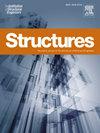Data-driven prediction method for flexural performance of ECC composite sandwich panels
IF 3.9
2区 工程技术
Q1 ENGINEERING, CIVIL
引用次数: 0
Abstract
To address the inadequate load-carrying capacity and ductility of precast concrete sandwich panels (PCSPs), as well as their inability to meet the current trend of lightweight and high-strength structures, this study proposes a novel engineered cementitious composite (ECC) composite sandwich panel (ESP) by applying ECC to the outer wythe. Existing design methods are unable to accurately quantify either the composite action between the inner and outer wythes or fully consider the complex design parameters when predicting the flexural performance of this new type of sandwich panel. In response, two normal concrete sandwich panels (NSPs) and two ESPs were first tested to reveal their flexural performance using a four-point bending test. Test results indicate that the application of ECC to the outer wythe can significantly improve the flexural performance of the sandwich panel, especially in terms of crack resistance and ductility. Subsequently, finite element parametric analysis demonstrated the impact of connector arrangement on the flexural performance, and design formulas for the degree of composite action (DCA) based on connector arrangement were proposed. Finally, a data-driven prediction model integrating experiments, finite element analysis, and neural networks was developed to accurately predict the flexural carrying capacity and ductility of the sandwich panel. By utilizing gene expression programming, the explicit function can be derived for the prediction model, which provides practical guidance for engineering applications.
数据驱动的 ECC 复合夹芯板弯曲性能预测方法
针对预制混凝土夹芯板(PCSP)承载能力和延展性不足,以及无法满足当前轻质高强结构发展趋势的问题,本研究提出了一种新型工程水泥基复合材料(ECC)复合夹芯板(ESP),将 ECC 应用于外墙。现有的设计方法在预测这种新型夹芯板的弯曲性能时,无法准确量化内外壁之间的复合作用,也无法充分考虑复杂的设计参数。为此,首先使用四点弯曲试验对两块普通混凝土夹芯板(NSP)和两块静电除尘器(ESP)进行了测试,以揭示它们的抗弯性能。测试结果表明,在外层应用 ECC 可以显著改善夹芯板的抗弯性能,尤其是在抗裂性和延展性方面。随后,有限元参数分析表明了连接器布置对弯曲性能的影响,并提出了基于连接器布置的复合作用度(DCA)设计公式。最后,开发了一个数据驱动的预测模型,该模型集成了实验、有限元分析和神经网络,可准确预测夹芯板的抗弯承载能力和延展性。通过利用基因表达编程,可以得出预测模型的显式函数,为工程应用提供了实际指导。
本文章由计算机程序翻译,如有差异,请以英文原文为准。
求助全文
约1分钟内获得全文
求助全文
来源期刊

Structures
Engineering-Architecture
CiteScore
5.70
自引率
17.10%
发文量
1187
期刊介绍:
Structures aims to publish internationally-leading research across the full breadth of structural engineering. Papers for Structures are particularly welcome in which high-quality research will benefit from wide readership of academics and practitioners such that not only high citation rates but also tangible industrial-related pathways to impact are achieved.
 求助内容:
求助内容: 应助结果提醒方式:
应助结果提醒方式:


